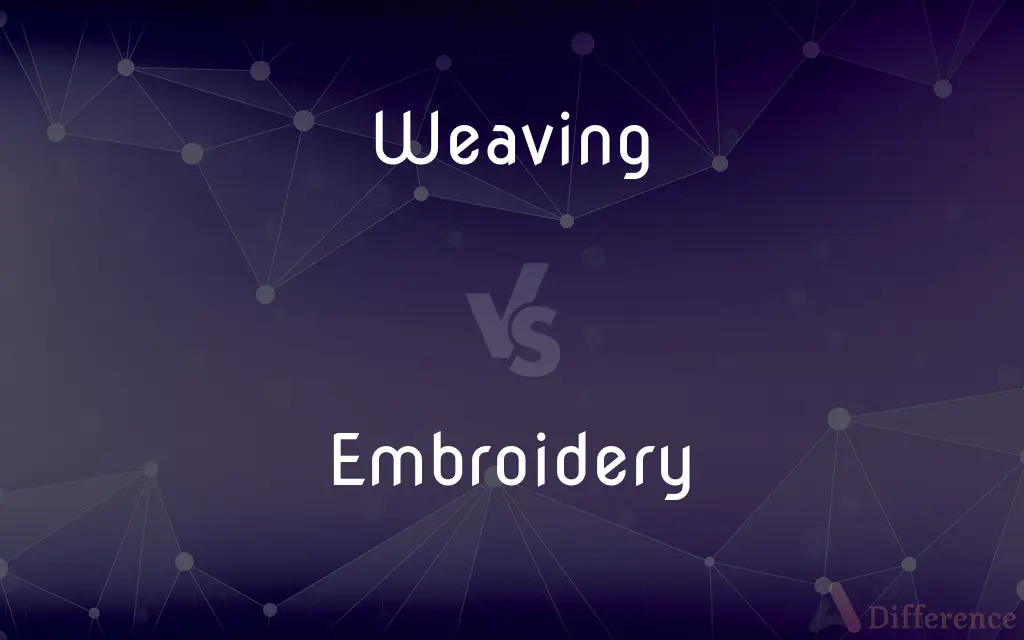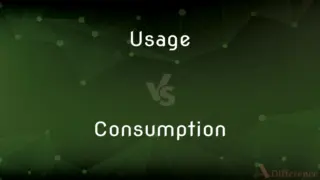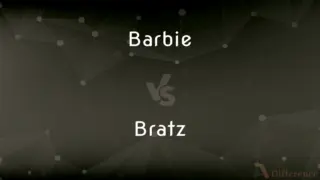Weaving vs. Embroidery — What's the Difference?
Edited by Tayyaba Rehman — By Fiza Rafique — Published on February 27, 2024
Weaving forms fabric by interlacing threads, whereas embroidery involves decorating fabric with needle and thread designs.

Difference Between Weaving and Embroidery
Table of Contents
ADVERTISEMENT
Key Differences
Weaving is the foundational process of creating fabric by interlacing two sets of threads, the warp (longitudinal) and the weft (transverse), on a loom. This technique produces various types of textiles, from simple linens to complex patterns. Embroidery, conversely, is an art form where designs and patterns are sewn onto an existing fabric using a needle and thread, adding texture, color, and embellishment.
The tools and materials for weaving and embroidery differ significantly. Weaving requires a loom to hold the warp threads taut, and the weft threads are interlaced through these. Embroidery is typically done with a needle and thread, sometimes utilizing an embroidery hoop to keep the fabric stretched and stable during the decorative process.
Weaving produces a piece of fabric, whereas embroidery is used to add decorative elements to an existing fabric. This means that weaving is often a more fundamental textile creation process, whereas embroidery is a decorative technique applied to textiles that have already been created through weaving or other methods.
The skill sets for weaving and embroidery are distinct yet both require a high degree of precision and creativity. Weaving involves understanding the mechanics of the loom and the interplay of warp and weft threads. Embroidery demands mastery in various stitches and an eye for design and color to create intricate patterns and images.
Both weaving and embroidery have rich traditions across cultures, each with specific styles and techniques that reflect regional histories and aesthetics. From the complex woven patterns of traditional Andean textiles to the intricate embroidery of Chinese silk, these crafts offer a window into the cultural significance of textile arts worldwide.
ADVERTISEMENT
Comparison Chart
Process
Interlacing warp and weft threads
Adding designs to existing fabric
Primary Purpose
Creating fabric
Decorating fabric
Tools
Loom, shuttle
Needle, thread, hoop
Skill Required
Loom operation, thread interlacing
Stitching techniques, design
Cultural Significance
Foundational textile technique
Reflects regional art and traditions
Compare with Definitions
Weaving
The method of creating patterns in fabric with warp and weft threads.
The intricate weaving resulted in a beautiful, patterned tapestry.
Embroidery
The technique of adding ornamental designs to textiles.
She learned embroidery from her grandmother, mastering various stitches.
Weaving
The act of forming fabric by interlacing threads.
Weaving on a traditional loom requires both skill and patience.
Embroidery
A piece of embroidered fabric.
Weaving
The craft of producing textiles on a loom.
His expertise in weaving was evident in the high-quality cloth.
Embroidery
The process of creating patterns on cloth with colorful threads.
Embroidery threads come in a wide range of colors for artistic expression.
Weaving
The technique of intertwining materials to form a cohesive structure.
Basket weaving is another application of the basic principles of weaving.
Embroidery
The practice of adorning garments with stitched decorations.
Traditional embroidery often incorporates symbols important to the culture.
Weaving
The process of assembling yarn to make fabrics.
Weaving has been an essential part of human civilization for thousands of years.
Embroidery
The ornamentation of fabric using needlework.
Weaving
To make (cloth) by interlacing the threads of the weft and the warp on a loom.
Embroidery
Needlework used to enrich textile fabrics, leather, etc.; also, the art of embroidering.
Weaving
To interlace (threads, for example) into cloth.
Embroidery
The art of decorating fabric with needle and thread.
The embroidery on the gown featured delicate floral motifs.
Embroidery
The craft of sewing designs onto fabric for embellishment.
The intricate embroidery on the pillowcase was hand-stitched.
Embroidery
The act or art of embroidering.
Embroidery
Embellishment with fanciful details.
Common Curiosities
What is the main difference between weaving and embroidery?
Weaving creates fabric by interlacing threads, while embroidery involves adding designs to existing fabric.
How do cultural traditions influence weaving and embroidery?
Cultural traditions dictate specific motifs, techniques, and uses in both weaving and embroidery, reflecting regional histories.
How do woven patterns differ from embroidered patterns?
Woven patterns are created within the fabric structure itself, while embroidered patterns are added on top of the fabric.
Is a loom always necessary for weaving?
Traditional weaving requires a loom to hold threads taut, but there are simpler forms like finger weaving that don't.
Are there automated processes for weaving and embroidery?
Both crafts can be automated: weaving with machines like power looms and embroidery with computerized embroidery machines.
Is there a significant difference in the tools used for weaving and embroidery?
Yes, weaving primarily uses a loom and related tools, while embroidery requires needles, thread, and sometimes a hoop.
How do environmental factors impact weaving and embroidery?
Material sourcing and production processes for both crafts can have environmental impacts, with sustainable practices increasingly adopted.
Can weaving and embroidery be combined in a single textile?
Yes, textiles often feature both techniques, with weaving creating the fabric and embroidery adding decorative elements.
How do modern advancements affect traditional weaving and embroidery?
Technological advancements offer new possibilities in efficiency and design but also challenge artisans to preserve traditional methods.
How does the choice of thread affect weaving and embroidery?
In weaving, thread choice impacts the fabric's texture and strength, while in embroidery, it affects the design's appearance and feel.
Can embroidery be done on any fabric?
Most fabrics can be embroidered, but the choice of fabric can affect the outcome and ease of the embroidery process.
Can both weaving and embroidery be considered forms of art?
Absolutely, both are highly regarded as art forms, with artisans creating intricate and expressive works in each medium.
What's the learning curve like for weaving and embroidery?
Both crafts require practice to master, with weaving being more technical due to loom operation and embroidery focusing on stitch mastery.
What role do weaving and embroidery play in fashion?
Both are integral to fashion, with weaving providing fabrics and embroidery adding aesthetic and luxurious embellishments.
How do maintenance and care differ for woven and embroidered items?
Care depends on the materials and techniques used; delicate embroideries may require more careful handling than sturdy woven textiles.
Share Your Discovery

Previous Comparison
Usage vs. Consumption
Next Comparison
Barbie vs. BratzAuthor Spotlight
Written by
Fiza RafiqueFiza Rafique is a skilled content writer at AskDifference.com, where she meticulously refines and enhances written pieces. Drawing from her vast editorial expertise, Fiza ensures clarity, accuracy, and precision in every article. Passionate about language, she continually seeks to elevate the quality of content for readers worldwide.
Edited by
Tayyaba RehmanTayyaba Rehman is a distinguished writer, currently serving as a primary contributor to askdifference.com. As a researcher in semantics and etymology, Tayyaba's passion for the complexity of languages and their distinctions has found a perfect home on the platform. Tayyaba delves into the intricacies of language, distinguishing between commonly confused words and phrases, thereby providing clarity for readers worldwide.
















































